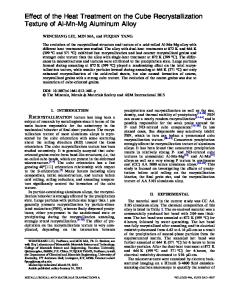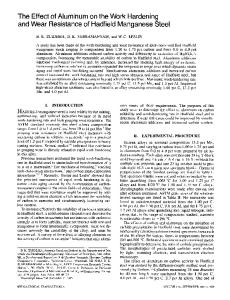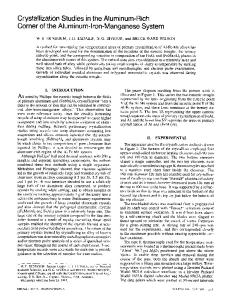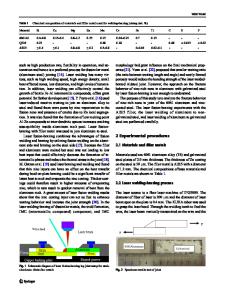The effect of iron and manganese on the recrystallization behavior of hotrolled and solution-heat-treated aluminum alloy
- PDF / 1,578,774 Bytes
- 9 Pages / 597.28 x 777.28 pts Page_size
- 36 Downloads / 280 Views
I.
INTRODUCTION
6013 is a recently developed alloy with a much higher yield strength, toughness, and dent resistance when compared to other 6XXX series predecessors. 6013 has a tensile yield strength comparable to 2024-T3, an aluminum alloy traditionally used for aerospace applications, while its corrosion resistance is much greater.t~ The potential for increased use of 6XXX series alloys in the demanding environments of the aerospace industry, however, has created a need for more insight into the effects of composition and processing on microstructure evolution. Recrystallization behavior is seen to be a very important characteristic of an aerospace alloy, since fracture toughness is often affected by the degree of recrystallization of the alloy.t2] In addition to being dependent on the amount of deformation, the recrystallization resistance of an alloy is a strong function of the elements in solid solution as well as the amount and morphology of the second-phase particles in the matrix. Since recrystallization seems to show some compositional dependence, it is important to know the effects of the alloying elements. 6013 contains copper, magnesium, silicon, manganese,
RICHARD A. JENISKI, Jr., Scientist, is with the Alcoa Technical Center, Alcoa Center, PA 15069. BUNCHA THANABOONSOMBUT, Scientist, is with the National Metal and Materials Technology Center, Rajdhevee, Bangkok 10400, Thailand. T.H. SANDERS, Jr., Regents' Professor, is with the School of Materials Science and Engineering, Georgia Institute of Technology, Atlanta, GA 30332-0245. Manuscript submitted October 8, 1993. METALLURGICALAND MATERIALSTRANSACTIONS A
and iron. Copper, magnesium, and silicon are elements commonly added to aluminum, and their effect on mechanical properties has been well documented. In most of the 6XXX alloys, Mg and Si combine to form Mg2Si during age hardening. However, if copper contents are close to 1 wt pct, Mg2Si, 0', and a third phase that might be a precursor to A14CuMgsSi4, known as the Q phase, appear. When present as very fine precipitates after age hardening, these phases combine to produce an alloy with a higher yield strength than 6061, 6009, and 6010. Copper, magnesium, and silicon are able to form precipitation-hardening phases since they are soluble and dissolve during high-temperature preheats. Transition elements, such as manganese and iron, have low diffusivities and solubilities in aluminum and tend to form different types of precipitates. In 6013, much of the manganese tends to remain in solid solution during solidification due to its low diffusivity in aluminum. However, some Mn can interact with Fe and Si to form a(AIFeMnSi) constituent particles in the interdendritic channels by eutectic decomposition. This phase is similar to that reported by Cooper and Robinson.t3J In the absence of Fe, the simple cubic phase a-Al~2Mn3Si, having Laue group PM3, forms, but when Fe is present, the bodycentered cubic phase ot(A1FeMnSi), having Laue group IM3, dominates. Although these two phases have different crystallog
Data Loading...











